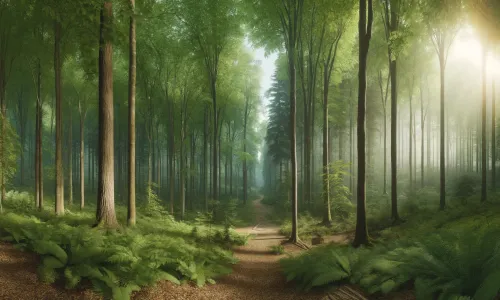
That so many copies of Peter Wohlleben's book The Hidden Life of Trees have been sold is no surprise. Life in the urban jungle can be overwhelming, and many of us long to escape by seeking more natural environments. We hope an encounter with nature might make us feel more 'alive'. Would we use this same term to describe nature itself, though? Forests and the trees that form them are commonly perceived as objects lacking awareness, like rocks or stones. But here, Wohlleben would beg to differ. From his observations, he has concluded that they are conscious in a way we do not fully understand.
In recent decades, a number of writers have investigated our planet's flora. The Cabaret of Plants by Richard Mabey and What a Plant Knows by Daniel Chamovitz, for example, have done much to reformulate our views about the green world. Central to many of these books is a serious message about sustainability, and The Hidden Life of Trees is no exception. What sets it apart is its approach to description: at the start Wohlleben announces that 'When you know that trees . .. have memories and that tree parents live together with their children, then you can no longer just chop them down.' Not everyone will be comfortable with this kind of anthropomorphism.
Nevertheless, Wohlleben's experience of working in a beech forest in the Eifel mountains of Germany may put him in a better position than many to write a book about trees. In the introduction, he explains that he started out as a state-employed forester, taking care of trees purely for industrial reasons. The straighter they were, the more high-quality logs could be sawn. But after a while he began to appreciate trees for more than just their commercial worth. He gives some of the credit for this realisation to the tourists that would come to the forest, who were more enchanted by bent, crooked trees, which did not conform to the straight ideal.
An anecdote that stands out is Wohlleben's encounter with 'the gnarled remains of an enormous tree stump' in the Eifel forest. More than anything else, it was this encounter that prompted him to look further into the hidden behaviour of trees. To his surprise, after scraping at the outside layer of bark covering the stump, he discovered a green layer underneath. This was chlorophyll, the pigment normally produced by living trees. Wohlleben realised that the only way the stump could still be alive was if the surrounding beeches were providing it with a sugar solution through their own roots. Wohlleben is not the first person to claim that trees are cooperative. In the 1990s, Dr Suzanne Simard realised that fir and birch trees were supplying each other with carbon. Simard's findings made complete sense to Wohlleben, who believes that this kind of nutrient exchange between neighbours is typical of a healthy forest. Wohlleben also had the opportunity to deepen his understanding of tree biology when researchers from Aachen University set up investigative programmes in his beech forest. Discussions with them reinforced his beliefs about the way trees thrived, and Wohlleben eventually found himself strongly opposed to some traditional forestry practices. He finally succeeded in persuading local villagers that the forest should be allowed to return to a natural state: this involved banning the use of machinery for logging, and giving up on pesticides for a start. Since then, Wohlleben has been noting how his beech forest has developed, and his observations formed the foundation for the book. Humour and a straightforward narrative make it instantly appealing to readers without a science background - elements that have successfully been translated into over a dozen languages. Those that do have scientific training, however, will be more demanding. Critics of Wohlleben point out that proper academic studies need to be done to prove all his claims are factually accurate. This seems a fair point. What the book will certainly do is transform nature lovers' experiences of a forest walk. Once you know what is happening below ground, you can't help but marvel at the complex life of trees. Will it transform the way we produce timber for the manufacturing industry? As large corporations tend to focus on immediate profits, they are hardly likely to adopt the longer-term practices that Wohlleben recommends.
One of these is allowing trees to grow nearer to each other. This is the opposite of what happens in many state-owned forests, where foresters deliberately space out trees so they can get more sunlight and grow faster. But Wohlleben claims this spacing prevents vital root interaction, and so lowers resistance to drought. Older, established trees, he explains, draw up moisture through their deep roots and provide this to juvenile trees growing below them. Without this assistance, they could die. The relationship between fungi and trees is also given attention. For instance, when pines require more nitrogen, the fungi growing at their base release a poison into the soil. This poison kills many minute organisms, which release nitrogen as they die, and this is absorbed by the trees' roots. In return, the fungi receive photosynthesised sugar from the pines. Then Wohlleben explores the way trees employ scent, giving the example of acacia trees in sub-Saharan Africa. When giraffes begin feeding on an acacia's leaves, the tree emits ethylene gas as a warning to neighbouring acacias. These then pump tannins into their leaves - substances toxic to giraffes. More controversial is Wohlleben's suggestion that trees feel pain. Although scientific research has now established that if branches are broken off or the trunk is hit with an axe, a tree will emit electrical signals from the site of the wound, the application of the concept of 'pain' might be an instance where readers are unconvinced.